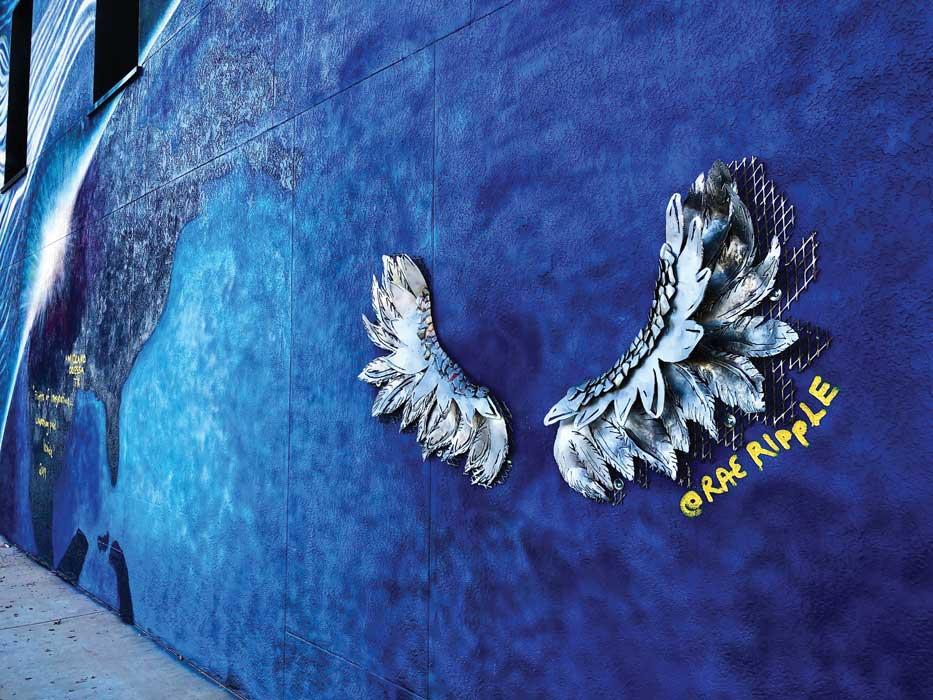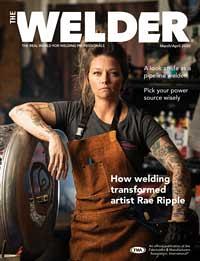- FMA
- The Fabricator
- FABTECH
- Canadian Metalworking
Categories
- Additive Manufacturing
- Aluminum Welding
- Arc Welding
- Assembly and Joining
- Automation and Robotics
- Bending and Forming
- Consumables
- Cutting and Weld Prep
- Electric Vehicles
- En Español
- Finishing
- Hydroforming
- Laser Cutting
- Laser Welding
- Machining
- Manufacturing Software
- Materials Handling
- Metals/Materials
- Oxyfuel Cutting
- Plasma Cutting
- Power Tools
- Punching and Other Holemaking
- Roll Forming
- Safety
- Sawing
- Shearing
- Shop Management
- Testing and Measuring
- Tube and Pipe Fabrication
- Tube and Pipe Production
- Waterjet Cutting
Industry Directory
Webcasts
Podcasts
FAB 40
Advertise
Subscribe
Account Login
Search
Artist breaking the cycle with welded metal art
How Rae Ripple's craft helped the Texas metal artist develop a better life
- By Amanda Carlson
- Updated January 25, 2023
- March 18, 2020
- Article
- Arc Welding

Rae Ripple of Big Spring, Texas, spent years fighting to break the cycle of toxicity that she grew up in. Art and welding opened doors that as a young adult she never thought were possible. Photos courtesy of Dom B. Photography, Euless, Texas
For a long time Rae Ripple felt like a piece of scrap metal. Used, neglected, discarded, and left to weather and corrode into nonexistence. The 34-year-old Big Spring, Texas, native spent years fighting and losing battles to break the cycle of toxicity—one that included drug-addicted parents, homelessness, and abuse.
But something inside her kept urging her to get up, even when she admittedly made decisions that pulled her back into the same vicious cycle she was trying to escape. There was more out there and she was destined to find it; she just didn’t know how.
In the middle of all of the darkness she became a mom, giving her a renewed purpose. A series of events led her to welding, which allowed her to take her artistic ability to the next level and has opened doors that, as a young adult, she never thought were possible.
Getting Caught in the Cycle
Ripple bounced around FABTECH at Chicago’s McCormick Place last November like a kid at a trampoline park. She posed for pictures with followers and fans; spent time meeting people and doing product demonstrations at booths like Hypertherm, Blue Demon, and Flame Tech; and was a guest on the Arc Junkies podcast episodes recorded that week. She was a woman in her element, and the joy she felt being around other welders, artists, and industry professionals who speak her language was written all over her face.
That wasn’t an act—she radiates joy, gratitude, and a genuine positive energy, which might surprise some people given her backstory.
“I grew up trailer trash,” Ripple said bluntly.
Her parents were drug addicts, they moved around a lot, and she spent most of her childhood feeling neglected. By age 14 Ripple had made the decision to remove herself from the home after an incident occurred. Even though she felt that living on the streets was safer than staying at home, it sucked her into a lifestyle that was equally difficult.
Through it all she continued attending school and eventually graduated, but was still very much lost. So much so that she attempted suicide.
At 17 she discovered she was pregnant, which gave her a new purpose.
“It changed my whole perspective on life and gave me a valid reason to live. And to continue to try harder for her because now I have her life in my hands, the last thing I wanted to do was raise her the way that I was raised.”
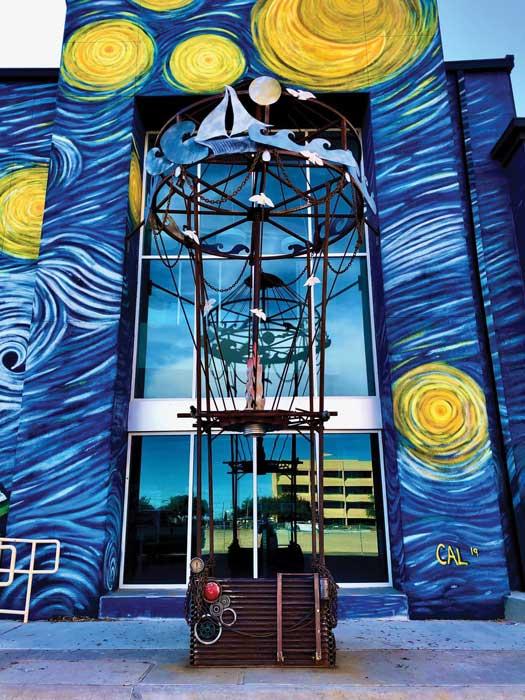
The hot air balloon, which Ripple said is the biggest structure her hands have ever built, is fabricated completely out of scrap metal from local oilfields and joined together with shielded metal arc welding.
But she was scared to death. Still homeless after her daughter Chloe was born, Ripple, still a kid herself, called her own mother from a laundromat pay phone.
“I asked her for help and she told me to prostitute myself. That was her advice. I didn’t, but I did turn to stripping instead.”
And what other choice did she have? She was able to make more doing that than she ever would working a minimum-wage job. This way she was able to feed, clothe, and put a roof over herself and her child. But even after she got off the streets, she found it difficult to escape the cycle. She had her second child and once again found herself in an abusive relationship.
“I guess I was trying to find validation that I didn't get as a child. I fell into a relationship with an alcoholic. It took my kid watching me get my head split open by this man before I made the choice to get out of there. I knew I couldn’t keep making the same mistakes and putting my kids in the same situations. I got out of it and kept pushing forward.”
Welded Metal Art Takes It to the Next Level
Constantly swimming upstream, caring for two children, and figuring out her own path in life were difficult to say the least. But Ripple did the best she could. She spent time as a tow-truck driver, helping people with broken-down cars or clearing the scene of a gruesome accident. It was an experience that inspired her to become a firefighter—to rescue people instead of cars.
Sketching and painting were Ripple’s creative outlet throughout all of the chaos, and her way of dealing with difficult circumstances. She felt like she had stuff in her head that she needed to get out, and the only way to do that was through drawing. Until she was introduced to metal.
“Somebody brought me a piece of sheet metal and was like, ‘Yo, can you paint my ranch logo on this piece of sheet metal?’ So I did.”
She was intrigued with metal and what else she could do with it. She progressed from painting on sheet metal to cutting sheet metal pieces with tin snips and joining them together with rivets and baling wire. She used this method to make a full-scale, intricately detailed metal dress. She had sketched it out on paper and spent months cutting, wrapping, and joining all of the pieces by hand without welding. It was a relief to finish, but it didn’t satisfy her need to work with metal.
“I wanted to take my work to the next level, and the only way to do that was to learn how to weld.”
With no money to spare for formal training, Ripple watched welding videos on YouTube and jumped at the chance to weld live at a friend’s autobody garage.
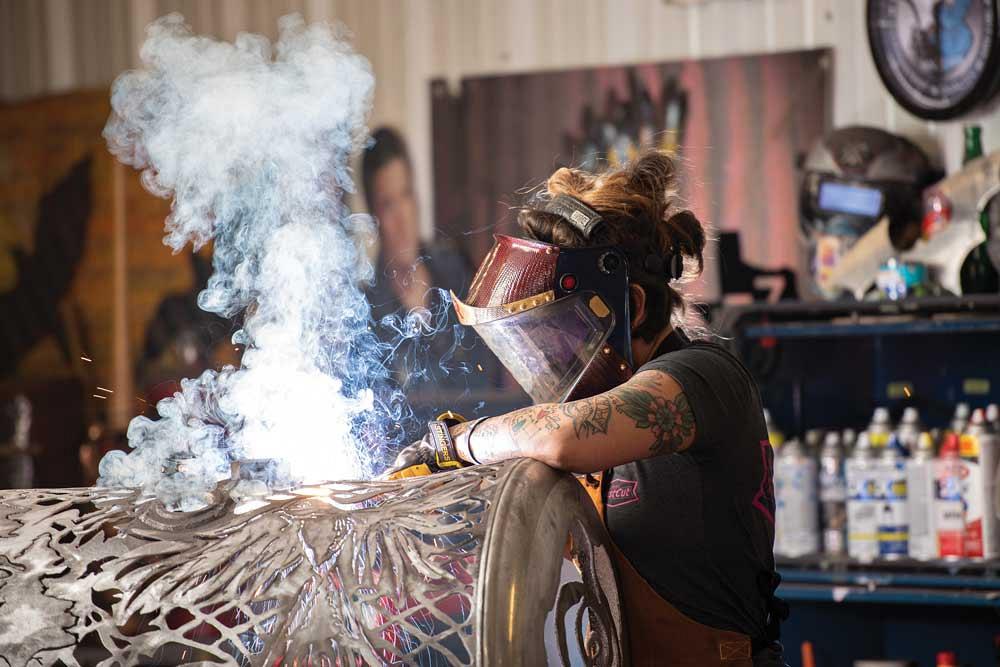
Ripple is an artist by nature who taught herself how to weld and use other metalworking tools for her art. She watched YouTube videos and hung out at a friend’s autobody shop, listening to welders and practicing on scrap metal.
“He said, ‘Have you welded before?’ By then I had already watched every YouTube video on how to weld that I could possibly find online. So, in my mind I was an expert, you know what I mean? I was like so ready; this was my moment.”
She loved welding immediately, even though she didn’t really understand the X’s and O’s like setting the amperage, mastering penetration, or even recognizing the basic lingo. She’d hang out with the guys at the shop, listen to them talk about welding, and then go home and Google everything they said.
She’d take pieces of scrap from the garage and practice. She learned what it looked like when her wire speed was too fast or too slow, what it looked like when she had too much or too little heat. Trial and error became her best instructor.
“I would use like their old exhaust and like all of this scrap that they had from these race cars that were laying around in their shop. And after hours I would just build stuff. The first piece that I ever built by myself was a Spartan helmet that I made out of an exhaust. And then I made a stand for it out of an old camshaft. It's crazy because when I look at it now, I'm like, dang, that’s so crappy!”
She would go to her friend’s shop after hours, build her scrap metal sculptures, and sell them for $20 to whomever would buy them, each time getting a little better and more comfortable and saving money little by little.
“When I was a tow-truck driver, I would get dispatched out to a crash, work that crash, and then go back into the shop and like continue building. I did this for a month until I finally saved up enough money to buy myself a plasma cutter, which sat in my living room for another six months before I finally had a place. When I got a place with a garage I could work in, I continued doing the same thing until I was able to buy my first little cracker box welder. Being a wrecker driver I knew where I could go and get scrap metal, so I'd just throw metal on the back of my wrecker and bring it home, mess with my plasma cutter and my little welding machine, and build whatever I could build. I kept on progressing to bigger pieces that were more challenging.”
Learning About Welded Scrap Metal Art
Even her career as a firefighter seemed to point her in the direction of metal art. She took a mandatory fire extinguisher class, and the only thing she could think about was what kind of metal the extinguisher was made of and the ways she could use it in her art.
“After the training was over with I went up and asked my instructor what type of metal it was. He said, ‘After all that, you want to know what kind of metal it’s made out of?’”
Whether it was the shape or the fact that it was metal and she was curious about what she could do with it, Ripple developed an idea to turn discarded fire extinguishers into art. After doing some research to learn how to remove the toxic chemicals so she could handle and cut them safely, she began hand cutting designs and patterns along the cylinder. She posted her work on Instagram and drew the attention of fire departments and regular metal art fans.
Some cylinders are red, others have had the paint cleaned off. Some have spiral cuts, both thin and thick, or crisscross cuts, and some feature customized metal patches with fire department numbers or other drawings.
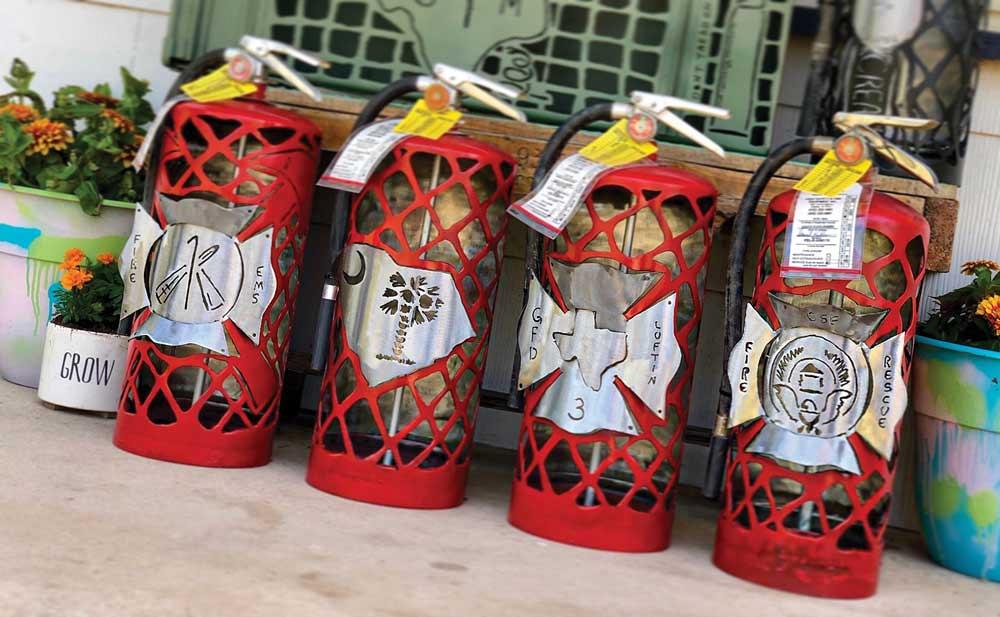
Ripple became a firefighter and immediately became interested in what she could make from discarded fire extinguishers. The result, after trial and error and a lot of research into how to handle and cut the cylinders safely, was unique and customizable pieces of art that drew local and international attention.
“I've been selling them all over the world, which is insane. I’ve had customers contact me from Australia, the U.K., and Canada. People send me a picture of their department’s patch and I'll re-create it and place it on the cylinder. It's crazy how that evolved just from a fire extinguisher class.”
She’s also hand-cut gas cans, old Harley-Davidson fenders, a diesel tank, a discarded toolbox, and even an old ammo box.
Go Big or Go Home
Ripple’s social media presence and metal art garnered the attention of equipment manufacturers like Fronius, Hypertherm, FastCut CNC, Flame Technologies Inc., Blue Demon Welding Products, and Benchmark Abrasives. She had always followed them on the platform and gradually each reached out to form a partnership with her to use their equipment. It came at the right time, because Ripple’s biggest challenge to date was right around the corner.
Mural artist Calina Mishay asked Ripple to join a bid for a new installation commissioned by the Midland Downtown Public Library in Midland, Texas. Mishay would handle all the murals while Ripple would design, fabricate, and install the metal sculptures.
“I just sent them some sketches of some ideas I had. After a long vetting process and lots of meetings, we ended up winning the bid. The crazy part is I had never built anything this big before,” Ripple said.
Her idea was threefold: She proposed building a hot air balloon that would sit at the entrance of the library; five plates with cutouts featuring Mary Poppins and four children following her; and a set of metal wings attached to the side of the building where people could stand and pose in front of them.
It was a big project and a big opportunity for Ripple to challenge herself and make a name for her talent in a public arena.
“I had to go big or go home. I needed it to be as big and bold as possible. Initially I was only going to make half of the hot air balloon and attach it to the building, but instead I decided I wanted to make a full 3D, freestanding sculpture. I lost so much sleep and had so many nightmares because I wanted it to be just right.”
The balloon’s design has a heavy steampunk influence, and due to the region’s deep roots in oil, Ripple wanted the materials she used to reflect that. All the pipe, gauges, and chains came from oilfields. The balloon’s basket is interactive—visitors can step inside it—and wheelchair-accessible.
For the five Mary Poppins cutouts she used 4-ft. by 8-ft. sheets of 3⁄16-in. steel with a patina and then cut each one by hand. She used sucker rod from the oilfields for the framework of each cutout. The hand-cut steel wings have features of varying sizes, textures, and designs. The project wrapped up late last year.
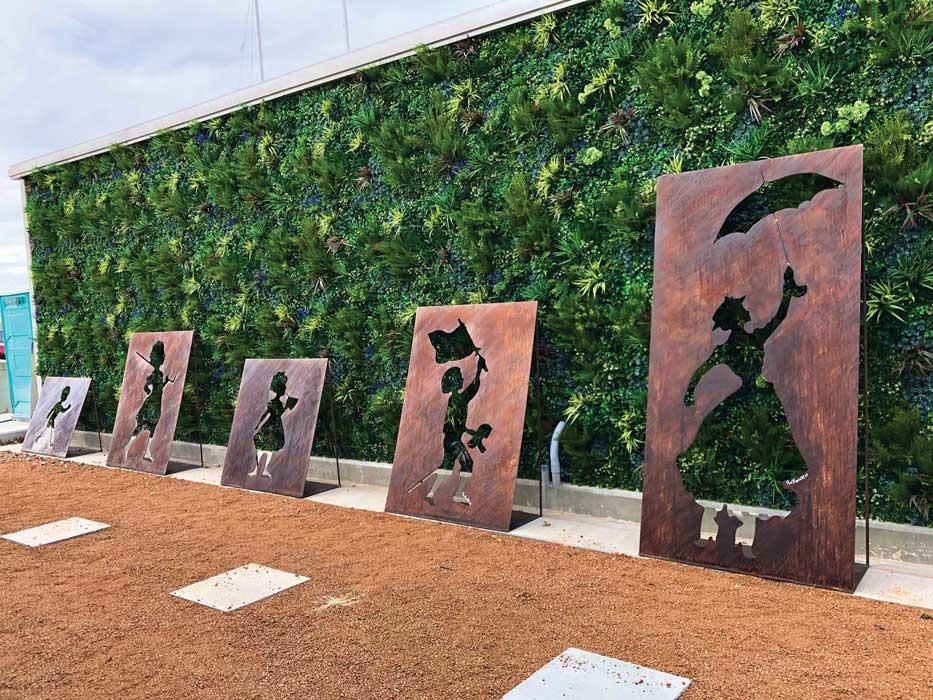
The five Mary Poppins cutouts, all done by hand with a plasma torch, are located in the library’s lobby.
“This was the biggest thing my hands have ever created. It took so much out of me. But I knew when Calina brought me this chance that it was my one shot to show the world what I can do, and it’s more than the little stuff I build in my shop at home.”
We All Have a Reason
If someone had told Ripple at 17 that she would eventually become a sponsored metal artist with more than 100,000 Instagram followers and had completed a massive public art installation, no doubt she would have said they were crazy. Her transformation has occurred not through perfection, but with a constant desire to keep getting up, do what is necessary, and try new paths. Art, metal, and welding have played a part in helping Ripple break the cycle she never asked to be a part of and write a new story for herself and her kids.
“But I remember looking at myself in the mirror the day that I tried to commit suicide. I saw myself and I realized that I don’t ever want my kids to feel that way. Everything I have done ever since then has been for them,” Ripple said.
Even though it’s difficult to relive painful moments in her life, Ripple shares her story pretty openly to help others.
“I taught myself how to weld and fabricate and build sculptures and artwork and now I get to do that full time because I hustled, I got lost, and I had to teach myself to keep moving forward even on the days that I didn't want to. I still struggle. I’ve talked about my life in front of high schools and middle schools. Sometimes I can’t recognize the person I’m talking about; other times it’s like I’m back to feeling like that 14-year-old who just ran away from home. We all have battles; it’s just a matter of us getting up and moving forward. No matter how bad things are, we all still have reasons to be here, whether it’s our kids or someone else who relies on us. We just need to learn how to rely on ourselves sometimes, and that’s what I did.”
Follow Rae Ripple's career and see her projects on Instagram.
About the Author

Amanda Carlson
2135 Point Blvd
Elgin, IL 60123
815-227-8260
Amanda Carlson was named as the editor for The WELDER in January 2017. She is responsible for coordinating and writing or editing all of the magazine’s editorial content. Before joining The WELDER, Amanda was a news editor for two years, coordinating and editing all product and industry news items for several publications and thefabricator.com.
About the Publication
subscribe now

The Welder, formerly known as Practical Welding Today, is a showcase of the real people who make the products we use and work with every day. This magazine has served the welding community in North America well for more than 20 years.
start your free subscription- Stay connected from anywhere

Easily access valuable industry resources now with full access to the digital edition of The Fabricator.

Easily access valuable industry resources now with full access to the digital edition of The Welder.

Easily access valuable industry resources now with full access to the digital edition of The Tube and Pipe Journal.
- Podcasting
- Podcast:
- The Fabricator Podcast
- Published:
- 04/16/2024
- Running Time:
- 63:29
In this episode of The Fabricator Podcast, Caleb Chamberlain, co-founder and CEO of OSH Cut, discusses his company’s...
- Industry Events
16th Annual Safety Conference
- April 30 - May 1, 2024
- Elgin,
Pipe and Tube Conference
- May 21 - 22, 2024
- Omaha, NE
World-Class Roll Forming Workshop
- June 5 - 6, 2024
- Louisville, KY
Advanced Laser Application Workshop
- June 25 - 27, 2024
- Novi, MI
























